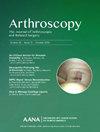在关节镜下进行肩袖修复术并同时进行髋臼成形术后,再手术率更低,患者报告的疗效更好:随机对照试验的最新系统回顾。
IF 4.4
1区 医学
Q1 ORTHOPEDICS
Arthroscopy-The Journal of Arthroscopic and Related Surgery
Pub Date : 2025-05-01
DOI:10.1016/j.arthro.2024.05.026
引用次数: 0
摘要
目的:本研究旨在通过对随机对照试验(RCTs)进行严格的系统性回顾,系统评估接受关节镜肩袖修复术并同时接受肩峰成形术或不接受肩峰成形术的患者的术后效果:本系统综述遵循系统综述和荟萃分析首选报告项目(Preferred Reporting Items for Systematic Reviews and Meta-Analyses,PRISMA)指南,旨在确定在至少 12 个月的随访期间,比较全厚肩袖撕裂患者接受关节镜下肩袖修复术和不接受肩峰成形术的临床疗效的 RCT。检索的数据库包括 PubMed、Web of Science、Embase 和 Cochrane Library。纳入研究的偏倚风险采用修订后的 Cochrane Risk of Bias 2 (RoB2) 进行评估。对至少有三项研究报告的结果进行了 Meta 分析,并根据异质性水平使用固定效应或随机效应模型计算了汇总效应估计值。结果以加权平均差(WMD)或几率比(OR)及 95% 置信区间(CI)表示。对于报告研究少于三项的结果,采用费雪精确检验,必要时进行连续性校正。主要结果包括再撕裂率和再手术率,次要结果包括美国肩肘外科医生(ASES)评分、活动范围(ROM)和并发症发生率的改善:五项高质量的 RCT 研究偏倚风险较低,涉及 409 名患者,显示出 58.4% 的男性、58.4 岁的平均年龄和肩峰类型:12.2%为I型,70.7%为II型,17.1%为III型。平均随访时间为 52.2 个月。两组的再撕裂率(12.5% 对 16.1%,P=0.536)和并发症发生率(OR,3.11;95% CI,0.31-30.73;P=0.33)相当。不过,肩峰成形术组的再手术率(5.3% 对 15.9%,P<0.001)和 ASES 评分改善率(WMD,3.99;95% CI,1.00-6.99;P=0.009)更高。两组的ROM均有明显改善,但由于数据不足,无法进行比较:结论:与单纯关节镜下肩袖修复术相比,关节镜下肩袖修复术联合肩峰成形术的再撕裂率和并发症发生率相似,但再手术率明显降低,ASES评分也有明显改善。现有数据不足以就ROM得出明确结论。由于样本量有限,这一结论并不可靠。本文章由计算机程序翻译,如有差异,请以英文原文为准。
Lower Reoperation Rate and Superior Patient-Reported Outcome Following Arthroscopic Rotator Cuff Repair With Concomitant Acromioplasty: An Updated Systematic Review of Randomized Controlled Trials
Purpose
To systematically assess the postoperative outcomes in patients undergoing arthroscopic rotator cuff repairs with or without concomitant acromioplasty through a rigorous systematic review of randomized controlled trials (RCTs).
Methods
This systematic review, following the Preferred Reporting Items for Systematic Reviews and Meta-Analyses guidelines, aimed to identify RCTs comparing clinical outcomes of patients with full-thickness rotator cuff tears undergoing arthroscopic rotator cuff repair with acromioplasty versus those without at a minimum 12-month follow-up. Databases searched included PubMed, Web of Science, Embase, and the Cochrane Library. The risk of bias in the included studies was assessed using the revised Cochrane Risk of Bias 2. Meta-analysis was conducted for outcomes with at least 3 studies reporting, with pooled effect estimates calculated using either fixed-effect or random-effects models based on heterogeneity levels. Results were presented as the weighted mean difference or odds ratio with 95% confidence intervals (CIs). Primary outcomes included rates of retear and reoperation, whereas secondary outcomes included improvement in American Shoulder and Elbow Surgeons (ASES) score, range of motion (ROM), and complication rate.
Results
Five high-quality RCTs, with low bias risk, involving 409 patients, revealed demographics of 58.4% males, mean age of 58.4 years, and the following acromion types: 12.2% type I, 70.7% type II, and 17.1% type III. Mean follow-up was 52.2 months. All involved studies reported comparable retear and complication rates between the 2 groups. However, the involved studies indicated a lower reoperation rate, and the pooled data demonstrated a statistically superior improvement in ASES score (weighted mean difference, 3.99; 95% CI, 1.00-6.99; P = .009) in the acromioplasty group. Both groups showed significant improvements in ROM, but insufficient data prevented a comparison.
Conclusions
Compared with arthroscopic rotator cuff repair alone, arthroscopic rotator cuff repair with acromioplasty demonstrated similar rates of retear and complications but had a significantly lower reoperation rate and superior improvement in ASES score. The available data were insufficient to draw a definitive conclusion regarding ROM. This conclusion is fragile due to a limited sample size.
Level of Evidence
Level II, systematic review of Level I and II studies.
求助全文
通过发布文献求助,成功后即可免费获取论文全文。
去求助
来源期刊
CiteScore
9.30
自引率
17.00%
发文量
555
审稿时长
58 days
期刊介绍:
Nowhere is minimally invasive surgery explained better than in Arthroscopy, the leading peer-reviewed journal in the field. Every issue enables you to put into perspective the usefulness of the various emerging arthroscopic techniques. The advantages and disadvantages of these methods -- along with their applications in various situations -- are discussed in relation to their efficiency, efficacy and cost benefit. As a special incentive, paid subscribers also receive access to the journal expanded website.

 求助内容:
求助内容: 应助结果提醒方式:
应助结果提醒方式:


